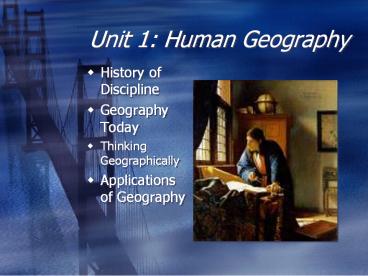Unit 1: Human Geography - PowerPoint PPT Presentation
1 / 24
Title: Unit 1: Human Geography
1
Unit 1 Human Geography
- History of Discipline
- Geography Today
- Thinking Geographically
- Applications of Geography
2
Human Geography
- Study of human activities on earths surface
- Discipline began 3,000 years ago
- Looking at the earth from a spatial perspective
means looking at how objects and processes vary
over the earths surface - Geographers look at how the world changes over
space
3
Eratosthenes
- Head librarian in Alexandria
- Accurate computation of earths circumference
- Based suns angle at summer solstice and
distance between two Egyptian cities - Coined term geography
4
Ptolemy
- Published Guide to Geography
- Included rough maps of landmasses
5
Western European explorers
- Bartholomeu Dias
- Christopher Columbus
- Ferdinand Magellan
- Alexander von Humboldt
6
18th - 20th Century
- Period saw development of
- Anthropology
- Geology
- Ecology
- Charles Darwin - theory of evolution through
natural selection - Alfred Wegner - theory of continental drift
- 1864-George Perkins Marsh - Man and Nature, or
Physical Geography as Modified by Human Action - Described impact on natural systems by humans
- Advocated conservationist approach
- Considered to be first environmentalist
7
Carl Sauer
- Cultural landscapes are product of complex
interactions between humans and their
environments - These should be main focus of geographic inquiry
8
Sauer contd.
- Implied that most places, even natural landscapes
(those unaltered by human activities) have been
affected indirectly by human activities - Created new form of human environmental relations
- Coined the phrase cultural landscape.
9
Quantitative Revolution
- Stressed use of empirical measurements
- Uses hypothetical testing
- Develops mathematical models
- Uses computers to explain geographic patterns
- Led to use of GPS and GIS
10
Global Positioning System
- Integrated network of satellites that orbit the
earth broadcasting location information to
hand-held receivers on the earths surface
11
Geographic Information Systems
- Use thematic layers
- Each layer consists of a map of specific features
- May be combined into one comprehensive map
- Helps geographers understand relationships
between themes
12
Human Geography
- Combines following subfields
- Political Geography - Political Science
- Population Geography - Demography
- Urban Geography - Urban Studies, Urban Social
Science Planning - Social Geography - Sociology, Language, Religious
Studies - Economic Geography - Regional Economics,
Economics - Behavioral Geography - Psychology, Economics
- Cultural Geography - Anthropology, Sociology,
History
13
Other Areas of Geography
- Physical Geography
- Study spatial characteristics of earths physical
and biological systems - Earth System Science - new field that studies
interaction between physical systems on a global
scale - Systematic Geography
- study the earths integrated systems as a whole
instead of one phenomenon in a single space
- Environmental Geography
- Where physical and human geography meet
- Anthropogenic - human induced environmental
change - Sustainability - implies an approach to the
environment that emphasizes the restraint in the
use of natural resources
14
W.D. Pattison
- 1964
- University of Chicago
- Claimed geography drew from four distinct
traditions
- The earth science tradition
- The culture environment tradition
- The locational tradition
- Area-analysis tradition
15
What does it mean to think Geographically???
- Develop a spatial perspective, an appreciation of
scale, and ability to analyze and interpret forms
of geographic data
- Spatial Perspective - intellectual framework that
allows geographers to look at earth in
relationships
16
Why and How Questions
- Why Starbucks are located and successful in
various parts of the world?
- How did Starbucks spread to those locations?
17
- Geography based on premise that all places are
different, with similarities - All places on earth are related - some more than
others - Geographers look at spatial patterns and spatial
relations
18
Scale
- Map scale
- Ratio between the distance on a map and the
actual distance on the earths surface
- Geographic scale
- Conceptual hierarchy of spaces - from large to
small, that reflects actual levels of
organization in the real world - Neighborhood, urban area, metropolitan area, the
region - Watershed, ecosystem, landscape, and biome
19
Regions
- Shared characteristics between places provide a
means to group places together into a more
manageable unit of study
- Area larger than a single city that contains
unifying social or physical characteristics
20
Regions (continued) . . .
- A unifying characteristic of a particular region
may be anything that defines that place for the
purpose of the particular question being asked - Regions do not exist as well defined units in the
landscape - Conceptual constructions that geographers use for
convenience and comparison - Regional Geography - Pattisons area-analysis
tradition, is the study of regions
21
Types of Regions
- Functional Regions
- Special identities because of social and economic
relationships - Referred to as Nodal Regions - due to
connections and interactions that occur between
them and surrounding areas
- Formal Regions
- Specific characteristics that are uniform from
one area to another within the region - Specific characteristics - physical features,
cultural properties
22
Regions (continued) . . .
- Perceptual Regions
- fuzzy borders
- Involve important issues of identity
- Sense of place - give people a special
attachment to that geographic place
23
Thinking geographically
- Qualitative data - often associated with cultural
or regional geography because they tend to be
more unique to and descriptive of particular
places and processes - Quantitative data - use rigorous mathematical
techniques and are important in economic,
political, and population geography - where
numerical data abounds
24
Idiographic vs. Nomothetic
- Idiographic
- Refers to facts or features that are unique to a
particular place or region - Such as its history or ethnic composition
- Nomothetic
- Refers to concepts that are universally applicable































